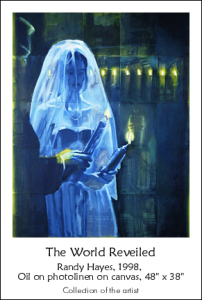Randy Hayes: The World Reveiled
November 7 – December 19, 1999
 The languid atmosphere o a summer evening after a heavy afternoon rain in the South creates a melancholic remembrance that is eternally etched in the psyche. Once you have experienced this quiet thick stillness of dampness and warmth, it resides in the back of your memory forever.
The languid atmosphere o a summer evening after a heavy afternoon rain in the South creates a melancholic remembrance that is eternally etched in the psyche. Once you have experienced this quiet thick stillness of dampness and warmth, it resides in the back of your memory forever.
This nostalgia of the mixture of luxurious feelings and the seductive fragrant smells of nature is a git many of us tend to miss, pass off or sadly complain of. Yet it stays protected by our desire to dream of the mysteries on our passage through life.
These lethargic visions, which we ring back at the most unexpected moments are the basis of Randy Hayes’ creative mythology. The apparently less than ordinary becomes the hero of our contemplation. A parked motorcycle in front of a screened country porch, a statue in a public park in the moonlight, a woman in a ceremony holding a lit candle — all could be passed and forgotten. But when they confront us, we weaken to their calling, to their image, to their memory, to their mythology.
Randy Hayes has the sensibility and gentleness to take these underplayed images and mold them into visions that become an eternal part o the visual vocabulary of the viewer. He uses the image the photograph and the paint to create memory upon memory to mesmerize our vision and connect it to our own biography our history our myths. Even though we do not know the specifics we see, we see the specifics in us and they help us see ourselves.
— Extracted from the foreword by Lloyd Nick Randy Hayes: The world Reveiled by John Yau, 1999Randy Hayes and His Work
Randy Hayes or combines the stop-action immediacy of photos with the timeless commentary o painting to produce provocative, many-layered images. His unique method of ‘veiling’ photographs with semi-translucent ashes of paint puns the themes which he illustrates.
During the first fifteen years of his career, Hayes focused on individuals whose identity is defined by how they present their bodies — such people as transvestites prostitutes strippers and boxers. For the last decade, he has shifted his interests to figures — usually women — who are veiled, turned away, or partially hidden by what they wear. In a sort of redefined cubism, Hayes uses a series of snapshots to present a scene from all sides and perspectives. Multiple views and moments invite the viewer to participate in the drama o the painting.
For the past to decades, Randy Hayes has lived and worked in Seattle although the subjects of his paintings have ranged far beyond his local environment. His road travels have taken him to sites throughout Europe and Asia as well as the southern United States, where he was born and raised. These travels have provided a rich source o photographs from which Hayes draws in creating his works.

